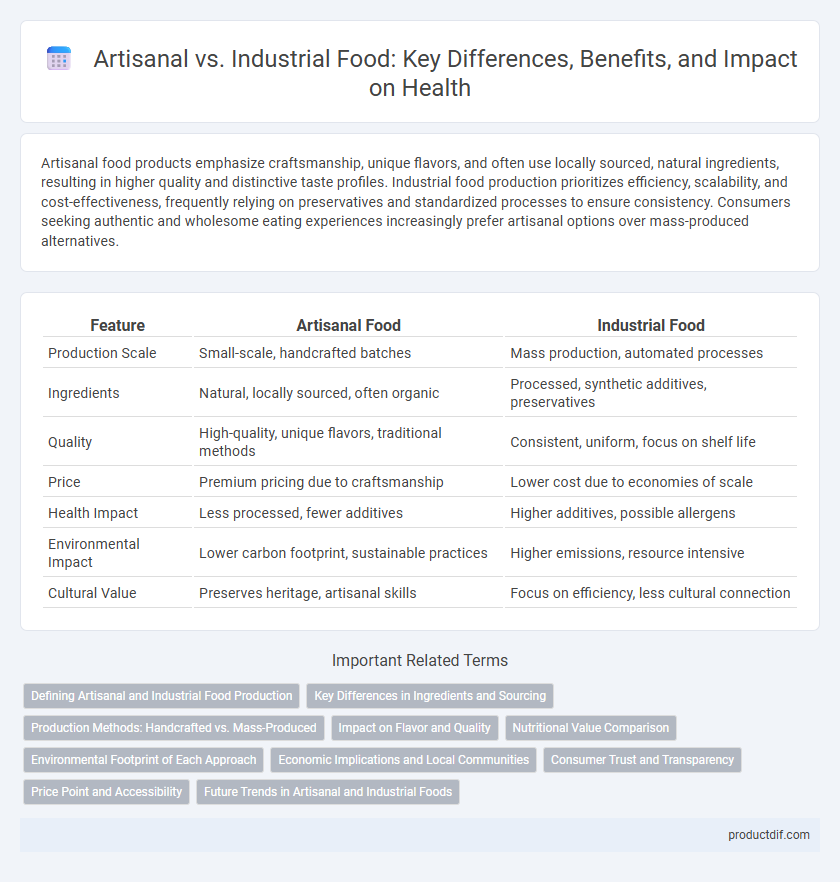Artisanal food products emphasize craftsmanship, unique flavors, and often use locally sourced, natural ingredients, resulting in higher quality and distinctive taste profiles. Industrial food production prioritizes efficiency, scalability, and cost-effectiveness, frequently relying on preservatives and standardized processes to ensure consistency. Consumers seeking authentic and wholesome eating experiences increasingly prefer artisanal options over mass-produced alternatives.
Table of Comparison
| Feature | Artisanal Food | Industrial Food |
|---|---|---|
| Production Scale | Small-scale, handcrafted batches | Mass production, automated processes |
| Ingredients | Natural, locally sourced, often organic | Processed, synthetic additives, preservatives |
| Quality | High-quality, unique flavors, traditional methods | Consistent, uniform, focus on shelf life |
| Price | Premium pricing due to craftsmanship | Lower cost due to economies of scale |
| Health Impact | Less processed, fewer additives | Higher additives, possible allergens |
| Environmental Impact | Lower carbon footprint, sustainable practices | Higher emissions, resource intensive |
| Cultural Value | Preserves heritage, artisanal skills | Focus on efficiency, less cultural connection |
Defining Artisanal and Industrial Food Production
Artisanal food production emphasizes small-scale, handcrafted methods using traditional techniques and local ingredients to ensure unique flavors and high quality. Industrial food production relies on large-scale, mechanized processes designed for mass distribution, prioritizing efficiency, consistency, and extended shelf life. The key distinction lies in artisanal producers maintaining craftsmanship and limited batches, while industrial operations focus on scalability and uniformity.
Key Differences in Ingredients and Sourcing
Artisanal food products emphasize high-quality, often locally sourced ingredients, focusing on natural and organic components with minimal additives or preservatives. In contrast, industrial food production relies on mass-produced, cost-effective raw materials that may include artificial additives to extend shelf life and enhance flavor. Sourcing methods in artisanal food prioritize sustainability and transparency, while industrial sourcing typically involves large-scale suppliers prioritizing efficiency and volume.
Production Methods: Handcrafted vs. Mass-Produced
Artisanal food production emphasizes handcrafted techniques, often involving small batches and traditional methods that preserve flavors and textures. Industrial production relies on mass-produced processes with machinery, enabling large-scale output but potentially sacrificing unique qualities. The difference in production methods directly impacts the authenticity, quality, and consumer experience of the final product.
Impact on Flavor and Quality
Artisanal food products often boast superior flavor and quality due to handcrafted techniques, small batch production, and the use of high-quality, natural ingredients. Industrial food production prioritizes scalability and consistency, frequently relying on preservatives, additives, and standardized processes that can diminish flavor complexity. Consequently, artisanal items tend to offer a richer taste experience and higher nutritional value compared to mass-produced industrial foods.
Nutritional Value Comparison
Artisanal foods often retain higher nutritional value due to minimal processing and use of fresh, natural ingredients, preserving vitamins and antioxidants that industrial foods may lose during mass production. Industrial food products commonly contain additives, preservatives, and higher levels of sugars and unhealthy fats, which can reduce overall nutrient density and impact health negatively. Studies consistently show that artisanal products, such as hand-crafted cheeses and bread, deliver richer micronutrient profiles compared to their industrial counterparts.
Environmental Footprint of Each Approach
Artisanal food production typically generates a lower environmental footprint due to smaller-scale operations, reduced energy consumption, and minimal transportation requirements. Industrial food production often involves intensive resource use, higher greenhouse gas emissions, and significant waste generation from large-scale processing facilities. Life cycle assessments reveal that artisanal methods promote sustainability through localized sourcing and decreased reliance on fossil fuels.
Economic Implications and Local Communities
Artisanal food production fosters economic growth in local communities by supporting small-scale farmers and preserving traditional skills, often resulting in higher-quality, niche products that command premium prices. Industrial food production, while benefiting from economies of scale and lower costs, can displace local businesses and reduce biodiversity, potentially leading to economic homogenization and decreased market opportunities for small producers. Investing in artisanal food systems enhances community resilience and maintains cultural heritage, contributing to sustainable local economic development.
Consumer Trust and Transparency
Artisanal food producers often build stronger consumer trust through transparent sourcing and small-batch production methods, which highlight authenticity and quality. Industrial food manufacturers face challenges in transparency due to large-scale operations and complex supply chains, sometimes leading to consumer skepticism. Clear labeling and open communication about ingredient origins are crucial for both sectors to enhance consumer confidence and loyalty.
Price Point and Accessibility
Artisanal foods typically come with a higher price point due to small-batch production and handcrafted quality, limiting accessibility for budget-conscious consumers. In contrast, industrial food products benefit from mass production and economies of scale, making them more affordable and widely available in supermarkets. This price disparity often influences consumer choice and market reach between artisanal and industrial food options.
Future Trends in Artisanal and Industrial Foods
Future trends in artisanal foods emphasize sustainability, local sourcing, and unique flavor profiles driven by consumer demand for authenticity and health-conscious choices. Industrial food production is integrating advanced technologies such as automation, artificial intelligence, and clean label formulations to enhance efficiency, safety, and nutritional value. The convergence of artisanal quality with industrial scalability is shaping a hybrid model that caters to evolving market preferences for transparency and innovation in food products.
artisanal vs industrial Infographic

 productdif.com
productdif.com